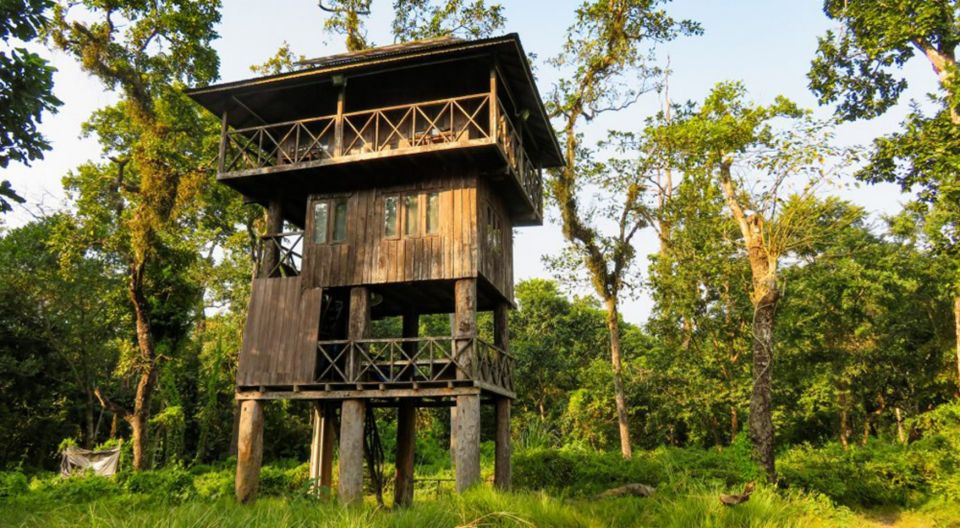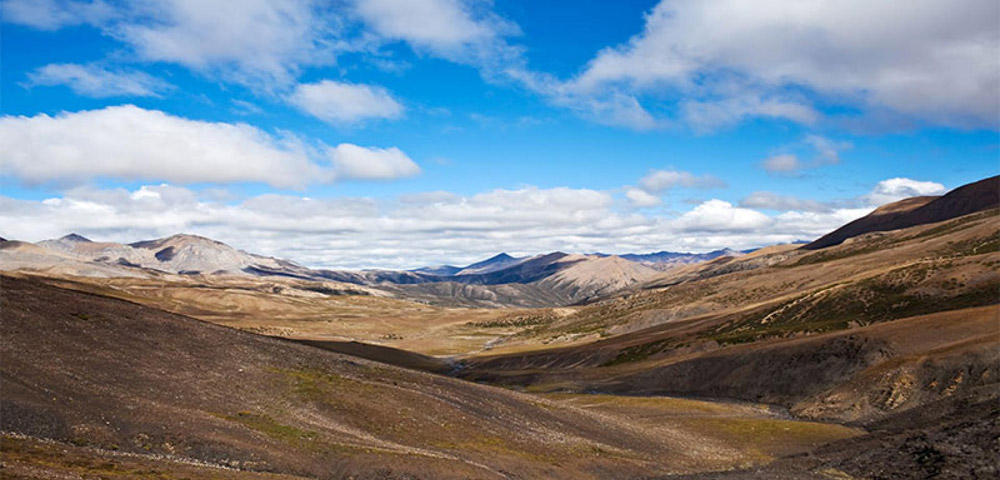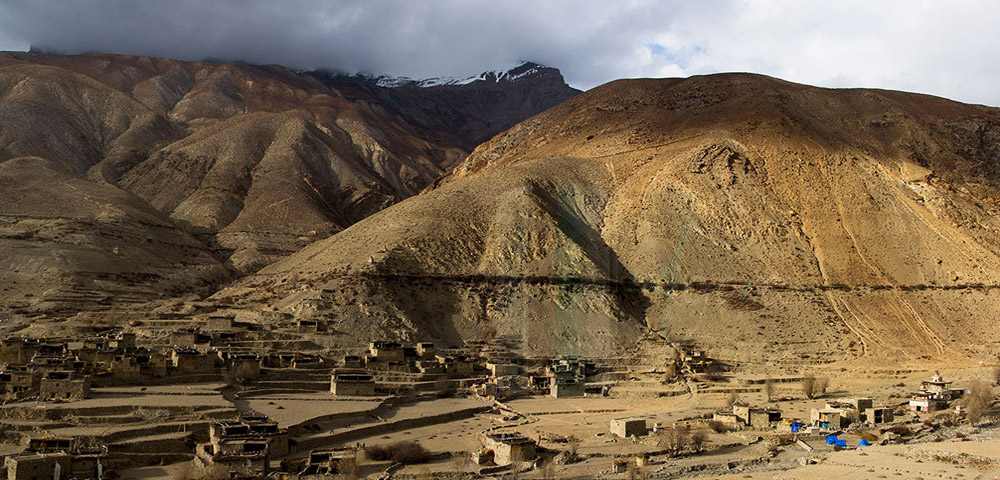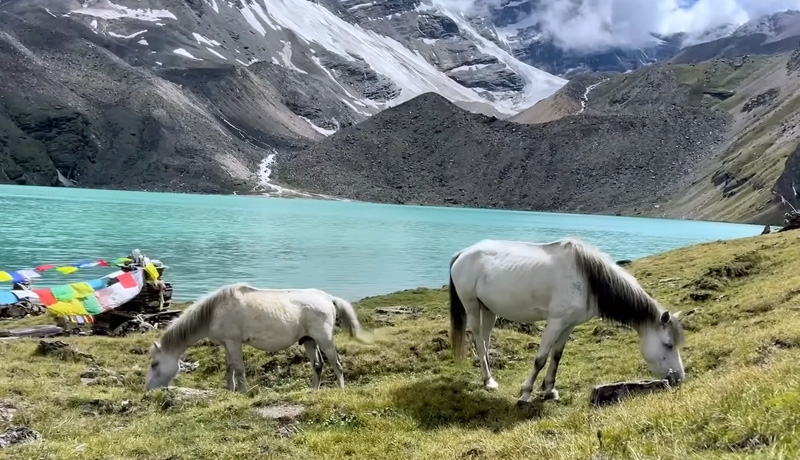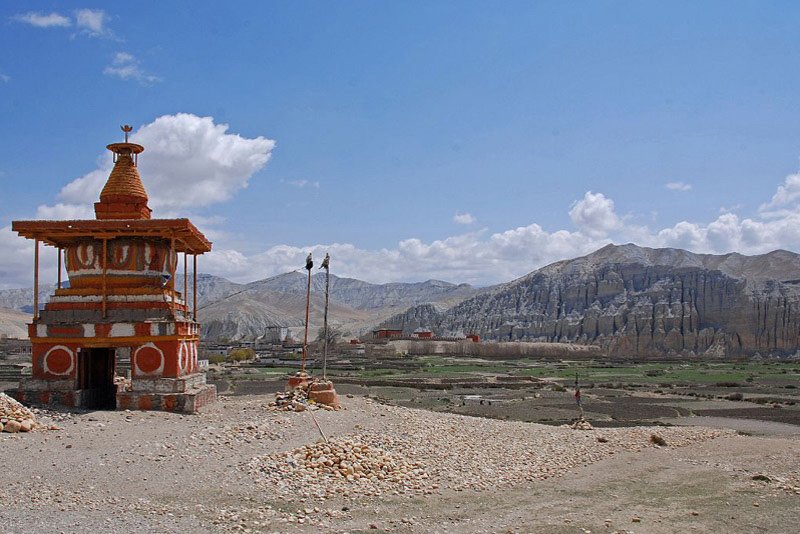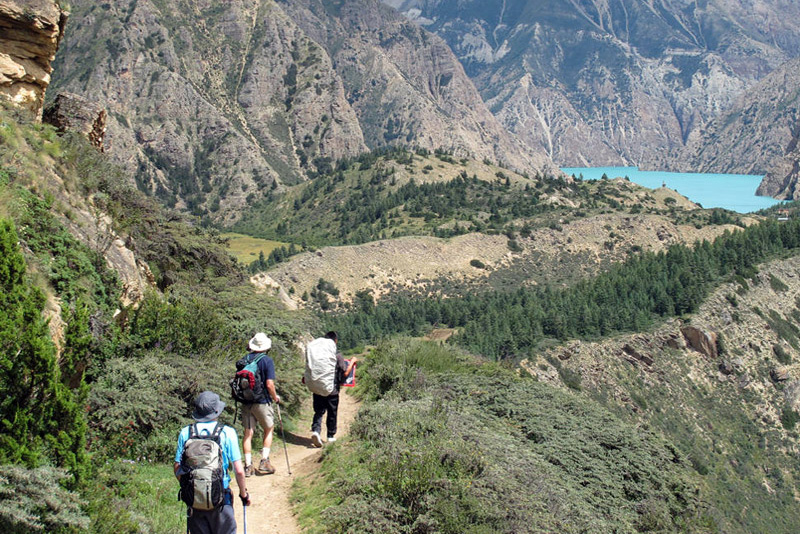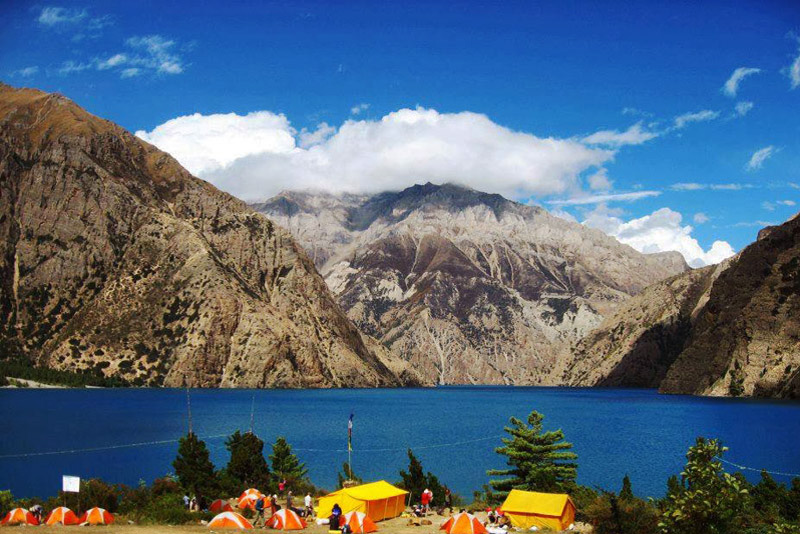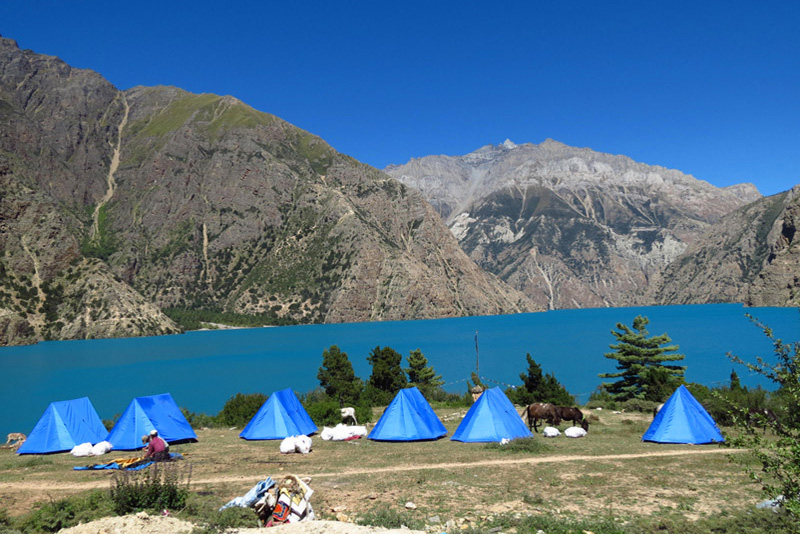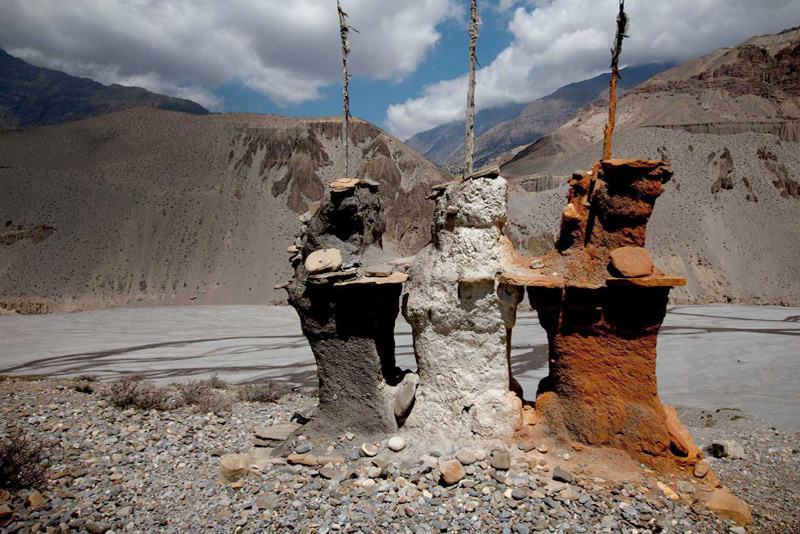Lower Dolpo Trek
Lower Dolpo Trek is one of the most interesting and difficult treks experience the true thrills of trekking on an untraveled path. This Trek is located in the western hills of Nepal. Lower Dolpo Trek is filled with natural wonders, such as Shey Phoksundo Lake, as well as the pre-Buddhist Bon Po culture.
The 18-day Lower Dolpo Trek begins with a flight via Nepalgunj from Kathmandu to Juphal. This trek’s starting location is Juphal. You journey through a semi-desert region with densely forested paths lined with pine, rhododendron, bamboo, and juniper trees, as well as vast meadows, brown scenery, and terraced fields of various hues. You enter Shey Phoksundo National Park, which is home to endangered species such as snow leopards, Himalayan musk deer, blue sheep, etc., while admiring the spectacular rain shadow environment of the Himalayas. The trekkers also climb two high passes: the trek’s highest point, the Numa La Pass (5309m), and the Baga La Pass (4610m) (5169m). Kugung La and Khyung La both offer spectacular views of Mount Dhaulagiri (8167m) and the Tibetan mountains. During the summer, we can observe yak and sheep caravans traveling to their destination. A further highlight of the walk is the blue Phoksundo Lake, which is surrounded by cliffs that climb 2,000 meters into the clear mountain sky. Tibetans and Magars continue to practice the pre-Buddhist Bon Po religion in the Dolpo region. In addition, the journey includes visits to the old monasteries (gompas) and Bon Po shrines that surround Phoksundo Lake. Overall, Lower Dolpo Trek is suited for intrepid hikers who enjoy extreme challenges.
Lower Dolpo Trek Highlights
The Lower Dolpo Trek is a remarkable trekking experience that takes you to the remote and culturally rich region of Lower Dolpo in Nepal. This trek offers a unique blend of untouched landscapes, ancient traditions, and a sense of wilderness adventure. Here are some reasons why the Lower Dolpo Trek is worth considering.
Untouched Wilderness: Lower Dolpo is one of the most remote and least developed regions of Nepal. The trek allows you to explore pristine landscapes and experience a sense of untouched wilderness that few other trekking areas can offer.
Diverse Landscapes: Trek through a diverse range of landscapes, including barren highlands, dense forests, alpine meadows, glacial rivers, and surreal landscapes that feel otherworldly.
Shey Phoksundo Lake: Encounter the stunning Shey Phoksundo Lake, one of the deepest lakes in Nepal. The turquoise waters against the backdrop of the surrounding hills and mountains create a breathtaking sight.
Shey Phoksundo National Park: Trek through the Shey Phoksundo National Park, home to a variety of flora and fauna, including blue sheep, snow leopards, and diverse bird species.
Rich Buddhist Culture: Experience the unique Tibetan Buddhist culture of the Dolpo region, characterized by monasteries, chortens, mani walls, and prayer flags. The region’s isolation has helped preserve these traditions.
Cultural Encounters: Interact with the local people, mostly of Tibetan origin, and learn about their way of life, traditional practices, and ancient customs.
Remote Villages: Visit remote villages like Ringmo and Tarap, gaining insights into the locals’ lifestyle and being immersed in the authenticity of their daily activities.
Challenging High Passes: Cross challenging high passes like Kang La (5,360 meters) and Sela La (5,094 meters), offering breathtaking views and a sense of accomplishment.
Unique Flora and Fauna: Observe unique plant species, such as the rare blue poppy, and potentially spot elusive wildlife like the snow leopard and Himalayan blue sheep.
Spectacular Views: Enjoy panoramic views of the surrounding peaks, including the Kanjiroba range and the Dhaulagiri massif.
Off-the-Beaten-Path: The Lower Dolpo Trek offers an off-the-beaten-path adventure, providing an escape from crowded trekking routes and an opportunity to experience a more remote and tranquil environment.
The Best time for Lower Dolpo Trek
The best time for the Lower Dolpo Trek is during the post-monsoon (autumn) season from September to November and the pre-monsoon (spring) season from March to May. These months offer the most favorable weather and trekking conditions for a safe and enjoyable experience in the remote and pristine Lower Dolpo region. These seasons also align with the accessibility of the region’s trails, as the snow has melted, and the paths are more navigable. Given the remote nature of the trek and the challenging terrain, trekking with an experienced guide or through a reputable trekking agency is crucial for a safe and rewarding experience. Proper acclimatization, physical fitness, and appropriate gear are also essential considerations for this trek.
When you arrive at Tibhuvan International Airport, our guide will pick you up and take you to your hotel in the bustling Thamel district of Kathmandu. Depending on your arrival time, you can choose to relax for the next journey, see the city’s attractions, or shop for adventure gear in one of Kathmandu’s many adventure supply stores. We’ll assemble our bikes and be ready for the journey in the afternoon.
Leaving the metropolis of Kathmandu behind, we fly to Nepalgunj while enjoying the gorgeous trip. Due to its location in western Nepal, close to the Indian border, Nepalgunj is an important business hub for several regions. Later in the evening, we can stroll through Nepalgunj’s bustling markets.
Today, we take a 35-minute flight from Nepalgunj to Juphal. As soon as we touch down in the Juphal, our trek begins. We reach the Bheri River by descending via local settlements and terraced fields. The walk continues along the riverbank and passes past the Roop Ghar with water mill before reaching Dunai.
Today, we will hike to Tarakot along the Bheri River’s upstream trail. In order to reach Tarakot, we hike over a level trail surrounded by picturesque scenery. As we ascend the slope, we encounter vast canyons, hanging bridges, and isolated towns. Tarakot, an ancient fortress town situated on a hillock to the south of the Bheri River, is greeted by dry stones and terraced fields of various hues as we continue our trek.
The trail on the southern side of the Bheri River that leads to the wide valley is followed. We next proceed east along the Bharbung Khola to reach Laisicap, where we will bridge the primary river. Following the flow of Tarap Khola, we now head north to Khanigaon, which provides a breathtaking view of Sandul Gompa across the valley. While appreciating the view of Putha Hiunchuli (7246) and the Churen Himal Range, we start the final ascent up the steep trail to reach Laina Odar. Spend the night in a tent camp in Laina Odar.
Today’s trek passes across the deep gorge of the Tarap River, ascending steep slopes high above the gorge. The trail gets more open and straightforward as we progress. On wooden planks and flat stones, we continue our journey to Chhyugar. We then cross a small stream, and a couple of hours of trekking gets us to Toltol, a winter village for Upper Dolpo residents.
Moving along the Tarap River’s bank, we gradually ascend to Kamattarka, the confluence of Tarap Chu and Lang Khola. To reach the settlement of Dho Tarap, we leave the tree line and enter a trail lined with wild rose and juniper shrubs after traversing a steep ravine. Dho Tarap is a beautiful town encircled by stone walls that was formerly a prominent trading hub for Tibet and Mustang merchants.
In order to acclimate to the thinner air, we take a day off from trekking to explore Dho Tarap. The remainder of the day is spent learning about and appreciating the local culture, traditions, and way of life by visiting the monasteries in the vicinity. The inhabitants of Dolpo wear handwoven garments and favor Tibetan-style somba (boots with upturned toes) as footwear. The majority of residents practice Bon-Po and Nyigmapa religions.
Today we travel towards Numa La Base Camp, moving alongside Tarap Chu River and ascending uphill till Tokyu, a traditional Kani village with an elegant walk. From there, we cross a bridge to Khanger and continue along the main route in a northwesterly direction. Then, we proceed up the treacherous path to reach Numa La Base Camp.
Today, we begin the tough journey towards the Numa La Pass (5310 meters). On the difficult and rough trail, we climb steeply to the tops of countless ridges. Once we reach the summit, we are greeted with breathtaking views of Mount Dhaulagiri (8167m) and the Churen Himal Range, as well as Norbung Kang (6085m). After a period of time, we descend alongside the Gyambo Khola and reach the magnificent Danighar meadow.
We leave Danighar and travel across another pass, Baga La, to reach Temche (5170m). Along the shabby yak trail, we undertake a difficult rise. The quick ascent in altitude may necessitate additional work as we ascend. In addition to sacred Chortens, the summit of the pass gives a magnificent view of Norbung Kang (6085m) and other peaks, as well as the hypnotic Phoksundo Lake. We next descend through a deep gorge and cross a frozen stream to arrive in Temche.
We first drop to Yak Kharka from Temche before ascending to the town of Ringmo via a trail lined with oaks, pines, juniper bushes, and cypress trees. We travel to Ringmo village, a well-known Bon town in the Dolpo region, accompanied by a breathtaking vista of tall cliffs and a massive waterfall. We reach the magnificent Phoksundo Lake through a short stroll from Ringmo.
We take an additional day off from trekking to explore Phoksundo Lake and Ringmo settlement. The Phoksundo Lake is a gorgeous turquoise lake that is also the deepest lake in Nepal. Lake provides a picturesque perspective of Ringmo village. Tshowa (Bon Monastery) was constructed 900 years ago and is located close to the Ringmo town. We also encounter numerous stunning glaciers above the lake region.
Today’s journey to Chhepka begins with a moderate stroll along the riverbank, followed by a sharp ascent to the summit of the hill, which provides the final glimpse of the lovely Phoksundo Lake. From there, we make our way to Chunuwar via a brief descent. The track continues through a pine and birch woodland towards Rechi. With a gentle uphill and downhill ascent along the trail, we reach Chhepka.
We leave Chhepka and travel to Juphal via the villages of Shyanta and Kageni. From Shyanta, we travel into the jungle to reach the Shey Phoksundo National Park checkpoint. Then, we cross the metal suspension bridge over Dhim Khola and hike to Juphal via a narrow trail and magnificent barley and wheat fields.
We take an early morning beautiful flight from Juphal to Nepalgunj. When we reach Nepalgunj, we board the next flight to Kathmandu. You are transferred to your hotel in Kathmandu, and the remainder of the day is at your leisure. In the evening, you can dine at one of the local restaurants in the capital city.
We reserve one additional day in case the flight is canceled due to bad weather or delayed for other reasons. Stay at a 4-star hotel in Kathmandu for the night.
Today we will take you to the airport to catch your flight out of Nepal. Alternatively, if you’d like to stay longer, we may make additional travel arrangements to assist you continue your Nepal experience.
- All necessary ground transfers.
- All necessary accommodations as per the itinerary.
- Tea House accommodations during the trek.
- Daily breakfast, lunch and dinner during the trekking.
- All necessary paper works.
- All necessary trekking permits.
- Experienced and First Aid-trained trekking guide.
- Strong, helpful porters.
- Comprehensive medical supplies.
- Trekking map.
- Insurance of all local team.
- Warm clothing and trekking gear for staff.
- Sleeping bag and trip duffle bag.
- Trekking certificate issued by us.
- Welcome and farewell dinner in Kathmandu.
- Nepal Visa fee.
- International flights.
- All meals not mentioned in inclusions.
- Personal expenses not stipulated.
- Optional add-ons.
- Gratuities.
You might also like...
Top Add-on Trips
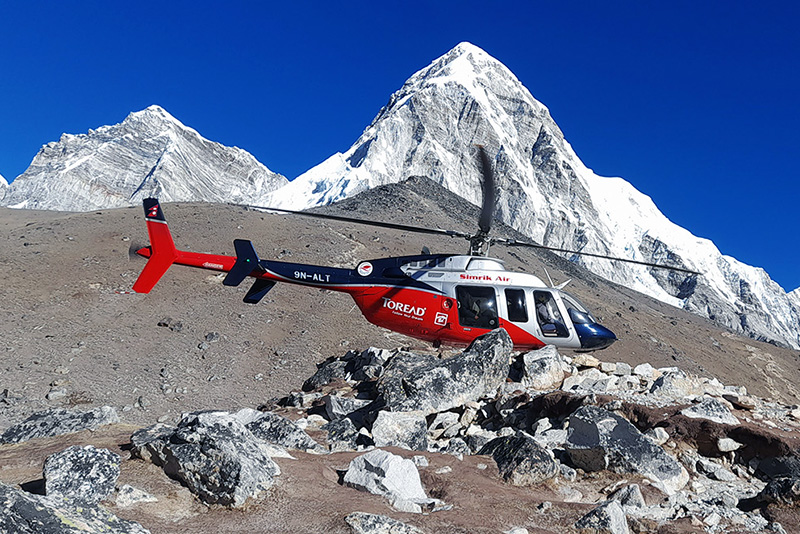
Everest Base Camp Helicopter Tour

Monastery Stay Tour
